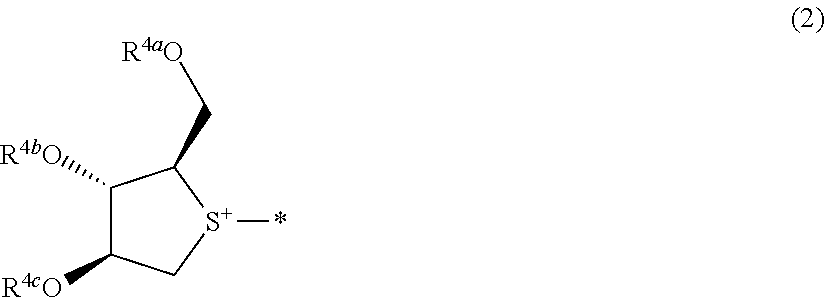Compound useful for manufacturing salacinol, method for manufacturing the compound, method for manufacturing salacinol, methods for protecting and deprotecting diol group, and protective agent for diol group
- Summary
- Abstract
- Description
- Claims
- Application Information
AI Technical Summary
Benefits of technology
Problems solved by technology
Method used
Image
Examples
reference example 1
[0422]
[0423]2.00 g of 60% sodium hydride was added to 15 mL of a N,N-dimethylformamide solution containing 1.50 g of (2R,3S,4S)-2-(hydroxymethyl)tetrahydrothiophene-3,4-diol at 0° C., and the resulting mixture was stirred for 1 hour at a temperature of equal to or lower than 5° C. Then, 4.50 mL of benzyl bromide was added thereto at 0° C., followed by stirring for 3 hours at 25° C. Ethyl acetate and water were added to the reaction mixture. An organic layer was collected by separation, washed with a saturated aqueous sodium chloride solution, and dried over anhydrous magnesium sulfate, and the solvent was distilled away under reduced pressure. The obtained residue was purified by column chromatography (hexane / ethyl acetate=95 / 5 to 86 / 14), thereby obtaining 2.31 g of (2R,3S,4S)-3,4-bis(benzyloxy)-2-((benzyloxy)methyl)tetrahydrothiophene as a colorless oily substance.
[0424]1H-NMR (CDCl3) δ values: 2.90 (1H, dd, J=4.8, 11.4 Hz), 3.04 (1H, dd, J=5.0, 11.4 Hz), 3.47-3.59 (2H, m), 3.69 (1...
reference example 2
[0425]
[0426]1.49 g of 60% sodium hydride was added to 10 mL of a N,N-dimethylformamide solution containing 1.12 g of (2R,3S,4S)-2-(hydroxymethyl)tetrahydrothiophene-3,4-diol at 0° C., and the resulting mixture was stirred for 30 minutes at a temperature of equal to or lower than 5° C. Then, 3.86 mL of 4-methoxybenzyl chloride was added thereto at 0° C., followed by stirring for 6 hours at 25° C. Ethyl acetate and water were added to the reaction mixture. An organic layer was collected by separation, washed with a saturated aqueous sodium chloride solution, and dried over anhydrous magnesium sulfate, and the solvent was distilled away under reduced pressure. The obtained residue was purified by column chromatography (hexane / ethyl acetate=95 / 5 to 86 / 14), thereby obtaining 1.93 g of (2R,3 S,4S)-3,4-bis((4-methoxybenzyl)oxy)-2-(((4-methoxybenzyl)oxy)methyl)tetrahydrothiophene as a colorless oily substance. 1H-NMR (CDCl3) δ values: 2.86 (1H, dd, J=4.8, 11.4 Hz), 3.03 (1H, dd, J=5.2, 11.4...
example 1
[0427]
[0428]1.1 g of tert-butoxypotassium was added to 200 mL of a tetrahydrofuran solution containing 20.0 g of (4S,5R)-4-(hydroxymethyl)-2-phenyl-1,3-dioxan-5-ol and 18.2 g of dimethyl methoxymethylene malonate at 25° C., and the resulting mixture was stirred for 1 hour at 25° C. Toluene was added to the reaction mixture, tetrahydrofuran was distilled away under reduced pressure, and then ethyl acetate and water were added thereto. An organic layer was collected by separation, washed sequentially with water and then with a saturated aqueous sodium chloride solution, and dried over anhydrous magnesium sulfate, and the solvent was distilled away under reduced pressure. The obtained residue was recrystallized from methanol, thereby obtaining 21.3 g of dimethyl 2-((4aS,8aR)-6-phenyltetrahydro[1,3]dioxino[5,4-d][1,3]dioxin-2-yl)malonate as a white solid. 1H-NMR (CDCl3) δ values: 3.75-3.81 (11H, m), 4.23-4.31 (2H, m), 5.30 (1H, d, J=7.8 Hz), 5.60 (1H, s), 7.35-7.39 (3H, m), 7.44-7.50 (2...
PUM
| Property | Measurement | Unit |
|---|---|---|
| Time | aaaaa | aaaaa |
| Electrical conductance | aaaaa | aaaaa |
Abstract
Description
Claims
Application Information
 Login to View More
Login to View More - R&D
- Intellectual Property
- Life Sciences
- Materials
- Tech Scout
- Unparalleled Data Quality
- Higher Quality Content
- 60% Fewer Hallucinations
Browse by: Latest US Patents, China's latest patents, Technical Efficacy Thesaurus, Application Domain, Technology Topic, Popular Technical Reports.
© 2025 PatSnap. All rights reserved.Legal|Privacy policy|Modern Slavery Act Transparency Statement|Sitemap|About US| Contact US: help@patsnap.com



